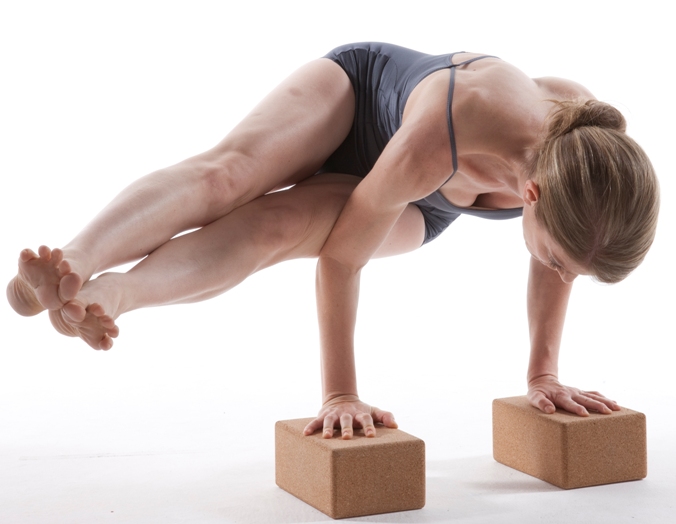
A strong core has been “in” for years. But the biomechanic awareness that has trickled into yoga and fitness studios has been affected by loads of misinformation and the “quick-build” mentality. Unfortunately, this can often do the body more harm than good.
A brief unauthorized biography of the core
1) The six-pack: It is commonly known now that doing excessive crunches might build a stronger rectus abdominis (the six-pack muscles), but the action of curling the spine repeatedly can ravage the back muscles and damage precious vertebral discs.
2) Navel to spine: Pilates introduced the transverse abdominal (TA) muscle into our vocabulary. We were told that this would protect our backs, as the TA acts like a cummerbund to pull in sagging guts and make us look like we’re wearing Spanx! The problem with pinning the navel to the spine is that students will often flair their ribs out to make the “appearance” of the navel drawing in the spine. But this actually creates a stretch and weakening of both the TA and the obliques!
3) Side bends: The obliques are often misrepresented as the ubiquitous “side-bending” muscle. They are actually two layers of diagonal abdominal muscles that are like crisscrossing sashes spiraling around our midsections. But biomechanically, the obliques are not all that functional in a side bend. It’s the quadratus lumborum, a deep lower back muscle, that is chiefly responsible.
So when reviewing this partial list of core muscles, it’s clear that they all need a new public relations firm in order to get firm — while keeping you safe! These fabulous muscles have been stripped of their dignity, oversimplified and reduced to dysfunctional, unintegrated tissues. Yes, making your core muscles actually think while they work can be hard work, but the payoff is a sounder structure that will support you for a lifetime!
3 core exercises that help your muscles think
Here are three great Yoga Tune Up® abdominal exercises that wake up and strengthen all of the major core muscles and more:
1) Corset Contraction: diaphragm, intercostals, TA, obliques, rectus, spinal erectors
Stand upright with good posture and place hands on either side of the ribcage. Inhale fully into the lungs with an expansive thoracic breath. Feel the spreading and flaring of the ribs as the external intercostals contract and the internal intercostals stretch.
Exhale and close down the ribs by tensing and contracting the internal intercostals to reset the ribcage. Intensify the end of the exhalation by drawing the bottom of the ribs down toward the navel and creating a binding action all throughout the midsection.
Continue to exhale until no breath is left, as if the whole torso were being corseted. Feel the blending of the internal intercostals with the obliques, transverse and diaphragm.
Practice eight to 10 complete rounds.
2) Megaplank with Active Serratus: rectus, obliques, TA, intercostals, serratus anterior (a shoulder-core muscle), pectoralis

The forearms are parallel to each other, shoulder-distance apart. Shoulder sockets are vertically joint-stacked over elbows.
Body is stiff as a solid board, while belly inflates slightly to ignite the abdominals into full tension.
To activate the serratus anterior, protract the shoulder blades by pushing the ground away while the upper back hunches, then depress the shoulder blades as if pulling a window shut while the arms remain pinned to the floor.
Maintain all actions at once. Hold for about 30 seconds.
3) Jithara Parivartonasana (revolved abdominal pose): obliques, TA, iliopsoas, quadratus lumborum, spinal erectors
Revolved Abdominal Pose A
Lay supine on a mat. Arms reach out to your sides like a “T,” with palms pressing into the floor. Keeping the thighs pinned together, legs stretch toward the ceiling stick straight (or slightly bent if hamstrings are tight). Inhale and glide the pelvis to the right about 20 to 30 degrees (fig. A).
Revolved Abdominal Pose B
Exhale as the waist twists and the legs descend toward the left hand, thighs maintaining a 90-degree or more acute angle with the torso at all times (fig. B). The legs do not touch the ground, and they hover during a new full inhalation.
Exhale and return the legs to face the ceiling, unwinding the core. Inhale and repeat on left side.
Do at least four complete rounds, and add one more round every practice.
Take your time with these exercises and coordinate your breath with your movements. Your abdominals are smart but also need you to think, so show them that you really care!
Check out Coregeous to strengthern your core.
Find one of our Yoga Tune Up classes near you.
Learn about our Therapy Ball Programs.



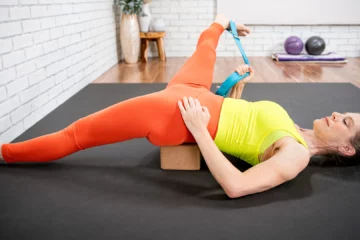
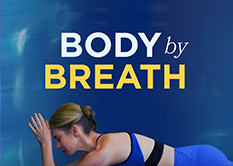
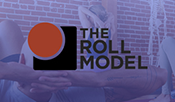
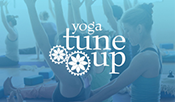


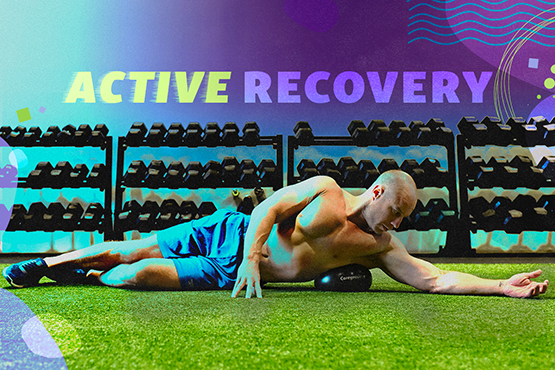
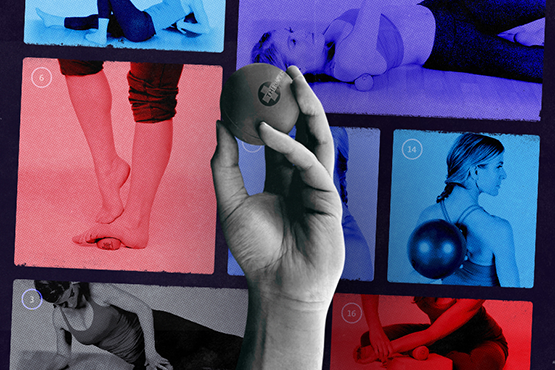
When the sole aim of our practice is about attaining mythical, flat, washboard abs, our abdominal cavity, and also our capacity for self-love, are stripped of their dignity. These exercises surely make students work smarter—not harder, with no back strain. Students (myself included) feel a new kind of burn performing these YTU poses that awaken core awareness and help “propriocept” what muscles are overworking or compensating for weakness. Thanks for the reminder that strong abs involve more than the rectus abdominus and necessitate a conversation between many torso muscles working in unison on the front, sides, back, top, and bottom of our core.
Well put, the abs “story” became so obsolete. Will integrate the above moves to my routine, thank you!
These are such effective exercises. I am in the middle of the Level 1 Certification with Todd and I have awakened my core, like never before doing these. Playing tennis this morning I was so more aware of my core. I really like that it is not necessary to do oodles of reps to feel the difference. I will incorporate them into my repertoire and add them to the toolbox!
I was looking for a quick core sequence post workout and this is perfect! 🙂
Every time I read these blogs I learn something new! I really appreciate your break down of “A brief unauthorized biography of the core” Understanding how clients can “cheat” navel to the spine by flaring the ribs and actually stretching the TA instead of strengthening it is so helpful in further understanding this cue. I also appreciate YTU core strengthening and spine stabilization so much more. Revolved Abdominals have changed my relationship to my core so much. When I first attempted these. I could not stabilize my pelvis in order to turn on the QL. It wasn’t just me – I witnessed it my students as well. It was like seeing a community blind spot! I’m going to quote you in class, Jill Miller – “Your abdominals are smart but also need you to think, so show them that you really care!”
All 3 of these are awesome! And I definitely did not realize that cuing the navel to the spine makes the ribs pop up!
I love this very functional and intuitive way to think about core strengthening and stabilization. The exercises described will be a great way to bring increased awareness to students about the function and purpose of the important muscles in their yoga practice but also in their daily activities.
Thank you for this blog and demything the abs. For years I “navel to spined” and posteriorily over tilted my pelvis. The Yoga Tune Up core exercise that resonated the most with me is the tubular core. The image was key for me! I hope more people read this article and embrace slow controlled exercises that work the whole core in remarkable ways. Quality of movement instead of quantity where people will frequently do 100 crunches. I’d rather do 4 jithara parivartonaosana’s correctly.
I have found the idea of tubular core to be a process that takes some time to integrate.The image of the”corset contraction” seems for me to directly address my flaring of the ribs. This also points out for me, time after time that I simply flare the ribs open to flex my shoulders. The megaplank helps me integrate core and shoulders, something that is new for me. I also found out after a while that a certain amount of tension in the body brings an impression of lightness, just not what you expect from that killer megaplank. Thank you are an inspiration.
The YTU training has made me very aware of my blindspots! Which is, of course, a major point of practicing in this way. A major blindspot for me is core weakness and a tendency to dump into my low back. It’s not easy, but I’m learning to engage my tubular core, align my xyphoid process and pubic symphysis and pull the ribs in and down toward the navel. Lot’s of work, lot’s of growth. One breath at a time.
Tubular core is a challenge to understand and utilize. I think i am getting better and better at it by implementing different directions. My entire body feels strongly supported when I engage tubular core. It is a new way for me and it is fun to retrain my body to do new patterns. I used to pull naval to the spine and it caused a lot of issues for me such as I could not do flex my spine (I could not do cat/cow any more) and it caused constipation. I read somewhere that naval to the spine flexes your spine and disturbs your digestion because digestion is downward movement but when I draw naval to spine I also draw it upward. Therefore downward bowl movement has to fight upward tension in the abdomen. I like tubular core because it supports my body from front to back and back to front like a sleeve on a coffee cup.
I am a pilates teacher and we are all about the core! I really appreciate this article and how it unravels some misconceptions about core strength. I just finished my YTU anatomy training and after what I have learned there, this article is coming full circle for me because some of the puzzle pieces that were missing (especially about the QL and obliques) are now fitting and making a whole lot of sense. Thanks again for bringing to light this information!
I love these Yoga Tune Up ways to access the muscles of the core. I’m especially fascinated with Mega Plank with Active Serratus at the moment as it requires engaging so many of the core muscles at the same time. I am able to find and engage the rectus abdominis and transverse abdominal muscles while keeping the rib cage knitted together.
Thanks – this article is so helpful. For years, I’ve been teaching the navel toward the spine, hugging the abdominals 360 degrees around but see how this only activates the transverse abdominus. I’ve neglected the obliques and rectus abdominus in many poses. With Yoga Tune Up’s help, I’ve rediscovered my ab strength and feel strong in supporting my spine. I’m able to maintain poses longer than ever with the YTU Tubular Core and so very grateful.
I will never use “navel to spine” again. I love Jithara Parivartonasana as a whole because it challenges my QL and obliques (which apparently are not as strong as I thought they were) and the best part is it really alleviates my lower back pain immediately.
I have recently become obsessed (but in a good way) with the transverse abdominals and I am so happy that in this article you covered “navel to spine” because I often talk about that as being a “passé” or “ancient way” of thinking about activating the core. The piece I was missing until now was that sucking in the navel towards the spine also causes the ribs to open and flair out. So thank-you for helping me understand that action better!
Jill – Thank for this eye opening article on the misunderstandings of the muscles of our core in our modern day world and thanks for a fantastic day 2 of YTU Level I Teacher Training. Today to say that learned about my core today for the very first time would not be an inaccurate statement. I really feel like I have now met my core muscles from corset contraction yesterday, to continuing to practice tubular core today, all the playful & yummy poses and movements we did to prepare for twisted triangle. What I want to remember not to forget is that the spine needs support from all sides not just my 6-pack.
thank you for this jill. i am like the “navel to spine” police! i hate that phrase. luckily, you will be happy to know, most well trained pilates instructors know not to say that,ever. unfortunately there are a lot of not well trained pilates instructors. i am so absolutely amazed at how misunderstood the entire abdominal core is by so many people, including the trainers i see at the gym doing some ridiculously un safe things with their clients. and the serratus anterior i think is the most important muscle in the whole wide core! because without it you cant really engage your “upper abs” and without your “upper abs” you cant feel the lower ones. so many clients ive had have completely changed their biomechanics just by taking the time to listen to a little lecture about whats ACTUALLY going on in there. plus, as a teacher, its way more fun to come up with images like “imagine youre wearing a dress with boning” and “theres a little elevator in your stomach going to your throat” and “hold in your pee!” than those other ones.
[…] Read about exercises for core strength. […]
These exercises are such great ways to get that true feeling of integration in the core ( as opposed to the common directive of pulling the belly in toward the spine). I love megaplank with active serratus because it feels so stabalizing throughout the entire body. Revolved Abdominal pose is super challengning for me, but it helps to work the QL and obliques in a much deeper way than many other poses. Thank you for these amazing exercises!
Throughout my life I’ve had “back issues” and 2 years ago it was so painful I didn’t want to get out of my bed. I was told by the rehab MD & PT that it was due to my lack of core strength. I’ve slowly been building up my core with starting yoga recently and now after learning your tubular core technique I feel I can advance even further. I really can feel the difference between “tighten your core” as some people say vs tubular-ize your core. YAY!
I love the revolve abdominal pose and it really makes a difference when you reminded me to pin my knees and ankles together. I will continue to practice the corset contraction, which is very challenging for me as I have tight intercostals, but I will make it a part of my personal fitness routine.
I have done all of these core excercises, they are so fun and bring a lot of awareness to your core and spine. I have a very flexible spine, which led to repetitive back issues, since strengthening my core, no back issues and I can do very deep backends without any issues, double win!!
I’ve heard and read quite a few articles now about the downside of crunches. I try to incorporate “crunchless” core work whenever I can just like the exercises you describe. I especially like the revolved abdominal pose that works the obliques, TA, iliopsoas, quadratus lumborum, and spinal erectors.
oh and for dawn and amanda – there are exercises to condition the serratus, basically from megaplank, one could “melt” the chest down between the shoulders to the floor, allowing for a retraction of the shoulder blades and then returning back to start with the full protraction of the shoulder blades. i’m thinking it it might not be good to cue someone with over kyphosis round but instead to lengthen. looking forward to hearing jill’s response to your question!
hi jill! i’m not sure how other pilates instructors have cued their students, but even though i’ve been classically trained, i have used the cue to pull the navel into the spine to identify the TA, but also, to keep the ribs pulled down by recruiting the obliques and rectus abdominus; this way its much more like the corset contraction to get all of the abdominals to work together to brace around the spine and torso. if anything, we encourage students to expand their back ribs by breathing into them, allowing more posterior space for the lungs. my pilates teachers have always been against the cue of “hollowing out the midsection” as this will cause students to flare their ribs out and not recruit any abdominal activity. in my pilates practice and teachings, these three exercises are totally similar – corset contraction/tubular core is the base of which we practice, megaplank with active serratus positioning is used in many exercises like the long stretch, balance control and all of our plank work; and jithara parivatonasana is a version of what we call “tic toc” or “corkscrew”
I always find core work challenging and have thought that perhaps doing crunches and other strength training exercises might help. Now I understand that that approach might cause more problems. I’m happy to pick up these three techniques for my core and will smile while doing them happy to be helping my core instead of hurting it.
About 3 months ago I started to focus on the tubular core after a weekend YTU workshop. The exercises I started with were sidewinder and abdominal focused crunches, my thoracic spine supported a squishy ball, now including the above mentioned exercises my core strength has improved so much and I love sharing these techniques with my fellow yogis. Thanks YTU
Thanks Jill, teaching fitness I was taught very tradition exercises and ideas about the core. Moving toward more functional fitness your ideas make absolute sense. This was a very informative blog with great exercises. As for Amanda & Dawn’s question I’m not sure either. I have a kyphosis tendency myself so that is a great question.
I had a similar question, Amanda. I was wondering if it’s recommended for people with kyphosis to practice megaplank with active serratus. It seems like creating a curve in the upper thoracic wouldn’t be the best idea for people with kyphosis, but maybe activating and engaging the serratus, while depressing the scapulae, would help tone the serratus and ultimately strengthen the upper back muscles. Does anyone have any ideas on this? Megaplank with active serratus for kyphosis — yes or no?
Yes, it was very interesting to learn how to utilize the serratus anterior to protract the shoulder blades today in class. Is this something that should always be done in plank or should it be alternated with retracting with rhomboids?
Awesome breakdown of what’s really at work in the core. What I like best about these poses is they work so many muscles in symphony with one another. While trying to work my core, I would always find that my legs or back would compensate for the core weakness in order to complete the exercise. This has the whole body working without being able to avoid turning on those key core muscles.
I cant wait to try these core strengthening techniques. Looking forward to adding them to my own personal practice. Especially curious about the corset one, sounds like a really interesting approach.
Thank you so much for these exercises! I have had difficulty building my core muscles through these traditional methods you mention and even in my yoga practice. I often find myself using my back muscles and even leg muscles to override my abs. I’m excited to try these exercises as they seem so focused and targeted, leaving less room for my back and legs to kick in and try to help. Thanks!
Core has always been in the center of my personal attention since I had my first kid. I’ve tryed all the possible ways to work it out: building a six-pack, cardio-abs, pilates core etc. Now as a beginning yoga teacher I am looking for new safe ways to keep core toned and weist-line beautiful. This article gives a new fresh perspective of core muscles and ways to activate them, and the detailed description of the exercises makes them easy to do and to incorporate into my yoga sequences.
These exercises are a fabulous way to strengthen the core muscles in a safe way. I definitely will be adding these to my exercise routine and skipping the crunches!! It’s terrific to find an effective way to keep the abdominal and back muscles in good shape to support so many asanas. My primary goal in my yoga practice is to feel great for years to come. It’s fabulous to have information out there that supports doing so in a safe way to reduce risk of injury.
Thank you for the exercises. I agree, photos and/or videos would be helpful! I look forward to trying these.
Thank you for clarifying the facts about our abdominal muscles and these exercises. Learning the anatomy in relation to yoga and yoga tune up exercises has helped me a lot in choosing the right poses and knowing what muscles are activated in each pose. knowing that in side bends we don’t use the obliques is an eye opener!
This triple view of the core strengthening techniques offered in the yoga tune up series shed a light on why many practioners still experience limited core strength even with lenghty practice of other postures. A good way to gain control of the tubular core muscles.
These abs exercises are fantastic. Any chance we can get a video demonstration??? My favorite is Mega Plank!
I am definitely going to do these exercises!!!
This biography of the core is so eye-opening – had many misconceptions about the core. And the three Yoga Tune-up exercises are great. Love that I can do the first one at work!
I never knew that crunches are not good for the back muscles. My core is weak from several abdominal surgeries, thanks for explaining these 3 core exercises that are also good for the back.
I am excited to try these exercises! Thank you.
Always looking for new ways to strengthen the core…thanks for the suggestions!
Theses exercises are fabulous – I speak from experience. I have difficulty with core strength, particularly the rectus abdominus. My spine has a transition vertabrae at S1…what that means is when my sacrum was fusing their vertabrae my S1 couldn’t decide to be a part of the sacrum or the lumbar spine. It chose the lumbar spine! If you look at an x-ray of that area it looks like I have 6 lumbar vertabrae instead of 5. This causes me to have an excessive lumbar lordosis and an anterior tilt to my pelvis.Like a J-Lo booty! These exercises really help bring awareness and strength to an area that has caused me some grief for years.
We learned about protracting the shoulders while in plank pose in the YTU training. Since then I have been trying to work on this in yoga practice – it makes a difference as you feel more stable. Thanks for the suggestions – I’m always looking to improve my abs!
Having taught pilates for several years, one of my frustrations has been the singular focus on shortening and tightening. What I love about revolved abdominal is how the spine lengthens and the obliques really lengthen as well as contract. What I’m not so crazy about is how aware I am now about how weak my right oblique is. I like cueing to start with knees bent to reduce the temptation to strain with the neck. I’ve also used megaplank, but on the hands to help facilitate bringing one knee forward to plant a. Foot to move into lunges, warriors, etc…it is amazing how quickly clients go from sagging hips to super strong abs by using should protraction.
your note about the 6 pack and the cumberbund is so interesting. thanks for these alternative exercises!
Thanks for reminding us that the diaphragm is a muscle that we can stregthen. I will definitely try that first exercise.
I liked your article. You were very specific on the core muscles targeted in each of the exercises you described which is very helpful. Thank you.
It’s great the way you are emphasizing the protraction of the shoulder blades to stay safe and properly support yourself in the plank pose.
Core work is my favorite and I’m always looking to add variety. These seem great, thanks.
Thanks for the tip about the risks from doing too many crunches! I will try the exercises you recommend.
I love these new suggestions for ways to strengthen my abs. Especially the first one, which I can do most anywhere!
I have really weak abs and I’m always looking for ways to improve them. This is a big help.